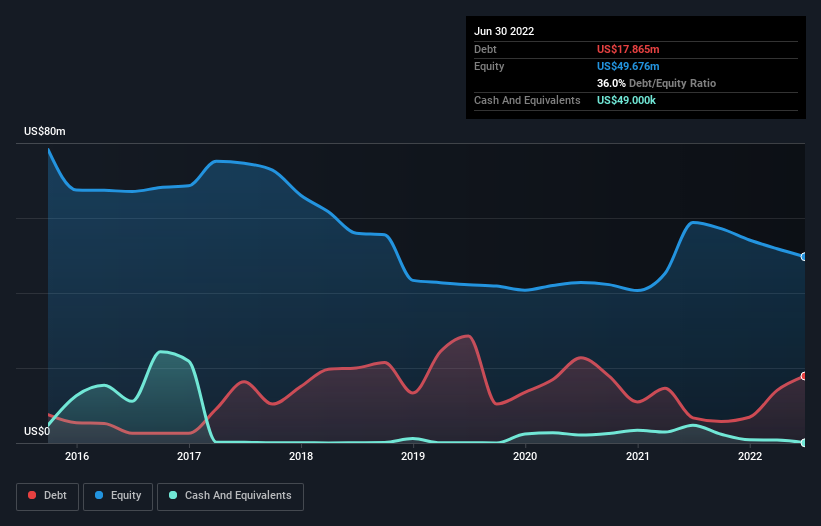Legendary fund manager Li Lu (who Charlie Munger backed) once said, 'The biggest investment risk is not the volatility of prices, but whether you will suffer a permanent loss of capital.' So it seems the smart money knows that debt - which is usually involved in bankruptcies - is a very important factor, when you assess how risky a company is. As with many other companies Broadwind, Inc. (NASDAQ:BWEN) makes use of debt. But is this debt a concern to shareholders?
Why Does Debt Bring Risk?
Debt is a tool to help businesses grow, but if a business is incapable of paying off its lenders, then it exists at their mercy. In the worst case scenario, a company can go bankrupt if it cannot pay its creditors. However, a more common (but still painful) scenario is that it has to raise new equity capital at a low price, thus permanently diluting shareholders. Of course, the upside of debt is that it often represents cheap capital, especially when it replaces dilution in a company with the ability to reinvest at high rates of return. The first step when considering a company's debt levels is to consider its cash and debt together.
See our latest analysis for Broadwind
What Is Broadwind's Debt?
The image below, which you can click on for greater detail, shows that at June 2022 Broadwind had debt of US$17.9m, up from US$6.71m in one year. And it doesn't have much cash, so its net debt is about the same.

How Healthy Is Broadwind's Balance Sheet?
We can see from the most recent balance sheet that Broadwind had liabilities of US$55.9m falling due within a year, and liabilities of US$21.3m due beyond that. On the other hand, it had cash of US$49.0k and US$24.5m worth of receivables due within a year. So its liabilities total US$52.7m more than the combination of its cash and short-term receivables.
This is a mountain of leverage relative to its market capitalization of US$72.7m. This suggests shareholders would be heavily diluted if the company needed to shore up its balance sheet in a hurry. The balance sheet is clearly the area to focus on when you are analysing debt. But ultimately the future profitability of the business will decide if Broadwind can strengthen its balance sheet over time. So if you're focused on the future you can check out this free report showing analyst profit forecasts.
Over 12 months, Broadwind made a loss at the EBIT level, and saw its revenue drop to US$158m, which is a fall of 9.1%. We would much prefer see growth.
Caveat Emptor
Over the last twelve months Broadwind produced an earnings before interest and tax (EBIT) loss. Its EBIT loss was a whopping US$10.0m. Considering that alongside the liabilities mentioned above does not give us much confidence that company should be using so much debt. Quite frankly we think the balance sheet is far from match-fit, although it could be improved with time. However, it doesn't help that it burned through US$14m of cash over the last year. So in short it's a really risky stock. When analysing debt levels, the balance sheet is the obvious place to start. But ultimately, every company can contain risks that exist outside of the balance sheet. These risks can be hard to spot. Every company has them, and we've spotted 5 warning signs for Broadwind (of which 1 can't be ignored!) you should know about.
Of course, if you're the type of investor who prefers buying stocks without the burden of debt, then don't hesitate to discover our exclusive list of net cash growth stocks, today.
Valuation is complex, but we're here to simplify it.
Discover if Broadwind might be undervalued or overvalued with our detailed analysis, featuring fair value estimates, potential risks, dividends, insider trades, and its financial condition.
Access Free AnalysisHave feedback on this article? Concerned about the content? Get in touch with us directly. Alternatively, email editorial-team (at) simplywallst.com.
This article by Simply Wall St is general in nature. We provide commentary based on historical data and analyst forecasts only using an unbiased methodology and our articles are not intended to be financial advice. It does not constitute a recommendation to buy or sell any stock, and does not take account of your objectives, or your financial situation. We aim to bring you long-term focused analysis driven by fundamental data. Note that our analysis may not factor in the latest price-sensitive company announcements or qualitative material. Simply Wall St has no position in any stocks mentioned.
About NasdaqCM:BWEN
Broadwind
Manufactures and sells structures, equipment, and components for clean technology and other specialized applications in the United States.
Good value with moderate growth potential.
Similar Companies
Market Insights
Community Narratives





